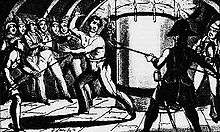Francis Spriggs
Francis Spriggs (died 1725?) was a British pirate who, associated with George Lowther and Edward Low, was active in the Caribbean and the Bay of Honduras during the early 1720s.
Early career
Although much of his early life is unknown, Francis Spriggs was first recorded serving as a quartermaster for Captain Edward Low (possibly as part of the original crew members who left the service of Captain George Lowther). However, after being given command of the recently captured the 12-gun British man of war the Squirel (renamed the Delight shortly thereafter), he and Low apparently had a falling out over the disciplining of one of the crew around Christmas 1724, resulting in Spriggs deserting Low in the night.
Spriggs & the Delight

After leaving Low, Spriggs and the crew began flying a black flag similar to Captain Low's and set sail for the West Indies. By January 28, 1725, he had looted a Rhode Island slaver captained by Richard Duffie.[1] Capturing a Portuguese bark en route, they looted the ship's stores while the crew were put through "the sweats" or a "sweat", a mild form of torture in which a ring of candles is lit in a circle around the mainmast and each crewman was made to enter the circle and run around the mast while the pirates poked and jabbed at them with pen knives, forks and other weapons in a sort of gauntlet. After they had finished with the bark, the crew were put back on their ship, to which the pirates set fire.
Upon their arrival in the West Indies, Spriggs and his crew captured a sloop near St. Lucia, a Martinique merchantman, and a vessel with a cargo of logwood which they tossed into the sea after carrying away as much as they could take. In early 1724, while in New England waters, Spriggs and the Delight received word of the death of King George I and discussed the possibility of gaining a royal pardon within the year after sailing from Rhode Island on March 27, 1724.
Adventures in the Bay of Honduras
By early-April, Spriggs anchored off Roatan near the Bay of Honduras, where he ordered many of the prisoners captured during the voyages to be put ashore. Many of these prisoners displayed wounds inflicted by the pirates during their captivity and were subject to forms of torture such as being forced to eat plates of candle wax.
Refitting their ship on a nearby island west of Roatan, Spriggs and the Delight sailed for Saint Kitts with the intentions of encountering a Captain Moor of the Eagle, a sloop which had earlier attacked George Lowther near Blanco.
However, they were soon met by a French man of war and forced to flee. After their escape, they captured a schooner near Bermuda and then, as they neared Saint Kitts, they captured a sloop on July 4, 1724. During this latest capture, the crew were tortured by Spriggs and his crew hoisting prisoners as high as the main or top sails and dropping them against the deck.
Shortly after this, a ship out of Rhode Island was captured with the pirates riding several of the horses it had been carrying out on the deck (after several accidents, however, the captives were blamed for not bringing along boots and spurs).
Return to the Bay of Honduras
After the capture of a sloop off Port Royal, Spriggs was forced to retreat from two British men of war, the HMS Diamond and HMS Spence. After their most recent escape, Spriggs captured another sloop and, on his return to the Bay of Honduras, took another ten or twelve English vessels before being chased off by a British man of war.
Briefly staying in South Carolina, Spriggs again sailed to the Bay of Honduras where he captured sixteen more vessels before fleeing from the same British man of war he had previously encountered. He again managed to avoid capture, although he became separated by a ship in his fleet commanded by a Captain Shipton. Little is known of his later career; according to newspaper accounts, he was still active in the region and, as of April 1725, had captured several more ships.
One newspaper account does suggest Spriggs was still active as late as 1726 when he was marooned on an island with another famous pirate, Edward Lowe. The report comes from the Post-Boy dated June 25, 1726. The only known original of the Post-Boy newspaper still in existence is owned by Eric Bjotvedt and states, in a front page report, that a sloop from the Bay of Honduras was taken by a Spanish vessel, but that later the Spaniards were captured and "...put on board the Diamond Man of War, who had taken a Pyrate, commanded by one Cooper, and had a great many Prisoners on board, and was bound to Jamaica with them ... [and] that Lowe and Spriggs were both maroon'd, and were got among the Musketoo Indians."
References
- ↑ Elizabeth Donnan (1932), Documents Illustrative of the History of the Slave Trade to America, vol. III, p. 118.
External links
- Flemming, Gregory. At the Point of a Cutlass: The Pirate Capture, Bold Escape, and Lonely Exile of Philip Ashton. (http://gregflemming.com), ForeEdge (2014) ISBN 978-1611685152
- "America's Worst Pirates" from gregflemming.com
- Rob Ossian's Pirate Cove: Francis Spriggs